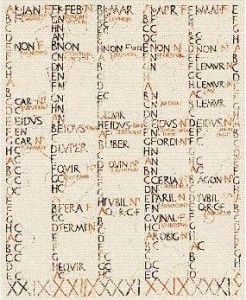
Calendars have become very closely involved in our lives in some form or other. They have become a useful tool for us to remember the important religious days, keeping appointments, planning various events, scheduling holidays etc
During ancient times men measured time based on the phases of moon and the environmental changes that result from the orbital movements of Sun. With the passage of time, due to the growth of civilization in the various communities throughout the world, a number of improved methods of measuring the time were devised, resulting in the creation of the modern day calendar.
The word calendar owes its origin to the Latin word??? Kalends???, meaning a ledger or accounts book. During various stages of the history of mankind, calendars were subjected to various forms of reforms by a number of scholars and astronomers resulting in the development of the modern day Gregorian calendar. This calendar having seven day week helps us to accurately measure the time.
Evolution of Gregorian calendar
It is generally believed that the first calendar was developed by Egyptians during 2500 B.C. Later on in 713 B.C , Numa Pompilius, the second king of Roman Empire promulgated a calendar reform that adjusted the solar and lunar years and included the months of January and February in the existing 10-month calendar .This reformed 12 month calendar was used as the official calendar throughout Rome
Julian calendar
The Julian calendar a reform of the Roman calendar was introduced by Julius Caesar in 46 BC and came into force in 45 BC. It was chosen after consultation with the astronomer Sosigenes of Alexamdria. It has a regular year of 365 days divided into 12 months, and a leap day is added to February every four years. Hence the Julian year is on average 365.25 days long.
The Julian calendar remained in use into the 20th century in some countries as a national calendar, but it has generally been replaced by the modern Gregorian calendar. It is still used by the Berber people of North Africa and by many national Orthodox churches. Those Orthodox Churches that no longer use Julian calendar typically use the Revised Julian calendar rather than the Gregorian calendar.
Gregorian calendar
The Gregorian calendar is the most widely used calendar in the world today. It is a reform of the Julian calendar, first proposed by the Calabarian doctor Aloysius Lilius, and decreed by Pope Gregory X111, for whom it was named, on 24 February1582 by papal decree .Years in the reformed calendar continued the numbering system of the Julian calendar, which are numbered from the traditional Incarnation year of Jesus, labeled as the “Anno Domini” (AD) era
The changes made by Pope Gregory also corrected the drift in the civil calendar which arose because the average Julian calendar year was slightly too long. The Gregorian calendar system dealt with the drawbacks in Julian calendar by dropping 10 days to bring the calendar back into synchronization with the seasons, and adopting the following leap year rule:
Every year that is exactly divisible by four is a leap year, except for years that are exactly divisible by 100; the centurial years that are exactly divisible by 400 are still leap years. For example, the year 1900 is not a leap year but the year 2000 is a leap year.
In the Julian calendar, all years exactly divisible by 4 were leap years.
Determining the length of Day
We measure the length of time from midnight up to the midnight of the following day as one day. But according to astronomers, an indigenous race called Umbri that lived in central Italy during the second century, defined a day as the time period from noon to the following day noon. Hebrews measured the time period from one sunset to the next sunset as a day. Babylonians, Egyptians Chinese and Hindu priests used to measure the time between two consecutive sun rises as a day.
Thus though all the ancient communities agreed that a day included day time and night time, they differed on how to calculate the length of a day.
Development of seven day week
Jews introduced the system of measuring time by using a seven day week and it was accepted by Greeks .It is believed that this system arose because each the four phases of Moon were seven days long and Babylonians considered seven as their holy number.
In any event, a seven day week based on heavenly luminaries eventually diffused both East and West, to the Romans via the Greeks, and to the Japanese via Indians and Chinese.
Hindu civilization employed a seven-day week, mentioned in the Ramayana, a sacred epic written in Sanskrit about 500 BCE, as Bhanu-vaar meaning Sunday, Soma-vaar meaning Moon-day and so forth.
Evolution of the names of months
The 12 months in a year have been calculated based on the growth phase of Moon. September, October, November and December were named based on the Latin numbering system. July and August were named after the Roman emperors Julius Caesar and Augustus Caesar .January and June derived their names from Greek Gods Janus and Juno. March was named after Mars, the Roman God of War. February was named after the Latin term februum, which means purification, via the purification ritual Februa held on February 15 in the old Roman calendar. The derivation of the name (Latin Aprilis) is uncertain. Since most of the Roman months were named in honor of divinities, and as April was sacred to Venus the Goddress of love, it has been suggested that Aprilis was originally her month Aphrilis, from her Greek name Aphrodite. There are no records regarding the origin of the name for the month of May.
History of change in the number of days in Roman-Gregorian calendars
- During the region of Romulus, a year consisted of 10 months and 303 days.
- In eighth century,Numa Pompulius, the second king of Roman Empire added two more months January and February and created a 12-month calendar consisting of 355 days.
- ??? After six more centuries, Julius Caesar paid a visit to Egypt and after consulting some scholars decided to introduce some changes in the existing Roman calendar.
With the advise of astronomer Sosigenes of Alexandria new calendar with 365 days was created It was divided into 12 months, and a leap day added to February every four years.
At the same time the seventh month of the year hitherto known as Quintilis was changed as July in honour of Julius Caesar.
- Augustus Caesar who ascended into power after the assasination of Julius Caesar changed the name of the eighth month from Sextilis into August in his honour.Also as per his request one day was reduced from February and added to August. As a result the number of days in February was reduced to 29 while the number for August was increased to 31 days.













